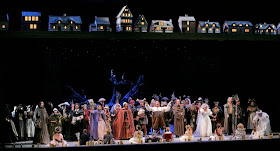It is possible that the perfect production of Verdi's Falstaff -- which plays in my head to the soundtrack of the classic recording with Tito Gobbi, Elisabeth Schwarzkopf, and Anna Moffo -- has spoiled me by setting the bar too high. The new production at Santa Fe Opera is visually diverting, witty, and convincingly staged, but a few deficits in the casting and musical realization, as heard on Tuesday evening, were insurmountable in terms of its ultimate success. The 30-something Broadway and now opera director Kevin Newbury has kept the action in the late 16th century of Shakespeare's Merry Wives of Windsor, framing his sets with half-timbered house walls and a proscenium frame bearing tiny models of Windsor cottages, which light up with a hearth-warming glow in the night. Newbury has described his production as focusing on the theme of childhood and claimed as a visual source of inspiration "Jan Steen’s paintings of lively domestic scenes."

Full cast in Act III, scene 2 ("Tutto nel mondo è burla")
of Falstaff, Santa Fe Opera, 2008 (photo © Ken Howard)
So far, so good. For the comedy to work, we have to like the conniving gossips of Windsor and the way of life they want to preserve, which is why trying to cast the protagonists of the opera as amoral gangsters was so misguided in the Kirov Opera production. Newbury has his Falstaff appear like a ridiculous buffoon from the outset, showing the Garter Inn as a lopsided, ramshackle barn, with the trophies of Falstaff's long-gone knighthood scattered around the room -- the liveried saddle and shield cast aside, the lance thrust into the wall. The childhood theme is incarnated in the supernumerary role of Falstaff's page-boy, played by the impossibly cute and composed Trevor Wilson, who fetches drinks and steals purses for Falstaff. In the final scene, a row of children sit facing the ensemble to receive the opera's final lesson, "Tutto nel mondo è burla" (Everything in the world is a joke).
Met's Peter Grimes earlier this year, he showed sure comic timing, exaggerating the fat knight's swagger and conceit in the Honor Aria, for example. Kelley O'Connor, the unforgettable Lorca in Ainadamar, was a comely Meg, while Claire Rutter was slightly shrewish vocally as Alice, although she had fairly sure control of the demanding passagework and (many) high notes. Nancy Maultsby had an almost masculine heft in the low-sitting part of Mistress Quickly, trading jabs with Michaels-Moore at every turn.
After a memorable turn as the Novice in Billy Budd, former Santa Fe apprentice singer Keith Jameson gave a rather funny, character tenor portrayal of Falstaff's lackey Bardolph, accompanied by the humorously tall Pistola of Wilbur Pauley, the Mutt to Jameson's Jeff. Former apprentice singer Franco Pomponi returned to Santa Fe as Ford, Alice's jealous husband, a role that is, in many ways, a parody of Verdi's jealous Otello. Pomponi did well to make Ford's sense of betrayal far over the top, singing with plenty of bluster and real anguish in the jealous aria.
 Anthony Michaels-Moore (Falstaff) and Trevor Wilson (Robin, the page-boy) in Act III, scene 1 of Falstaff, costumes by Clare Mitchell, Santa Fe Opera, 2008 (photo © Ken Howard) |
This opera was conductor Paolo Arrivabeni's American debut at the podium, and he did many things well, like the instrumental and choral parts of the fairy scene, which were transparent and leggiero, a lacewinged and elfen spectacle. At the same time, this score is one of Verdi's most complicated, and the many musical jokes in it need careful coordination to pull off. The final fugue was solid, but the juxtaposition of the male and female ensembles, where a duple versus triple effect reveals the opposition of the sexes in Windsor, was all over the place, more a chaotic jumble of rapid notes than a tableau centered around a consistent rhythmic pulse. This can be due to any number of reasons, including singers rushing ahead of one another, but a strong conductor can quickly right an ensemble train gone off the track.
Scott Cantrell, Santa Fe Opera's 'Falstaff' lacks consistency (Dallas Morning News, July 31) Kyle MacMillan, Opera's "F's" deserve "A's" in Santa Fe's productions (Denver Post, July 5) |
Verdi's Falstaff will be repeated at Santa Fe Opera on August 4, 11, 16, 19, and 23.

I understand that the role of Nanetta was billiantly performed in the final weeks by the young soprano, Jennifer Forni. Were you able to see any of these performances and would you offer an opinion?
ReplyDelete